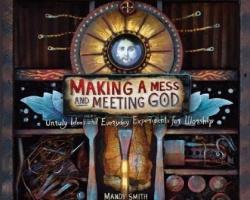I’ve always enjoyed making messes. As a kid, I made mud pies and built forts. I have great memories of taking all the toys out of a storage cabinet in order to create a sleeper car like on a train.
As a youth pastor, this love of messiness continues. With my students, I’ve made messes with everything from gold glitter used for “the dust of the king,” to sand and rocks creating deserts for Lent, to shaving cream and water for our annual “mess fest.”
Whether we’re getting candle wax on the furniture or pizza sauce on the carpeting, too often we get in trouble for making messes. Author (and friend) Mandy Smith believes that making messes is spiritual and an excellent way to encounter God.
Mandy is the associate pastor in charge of worship at University Christian Church across the street from the University of Cincinnati. Her new book Making a Mess and Meeting God: Unruly Ideas and Everyday Experiments for Worship gives us all permission to be messy with the God of creativity.
Mandy is a kindred spirit. When I read her book, I wanted to use it right away as my new devotional and thought it might be great for you, too. Why? Because it’s important for us as leaders to take time to engage God on our own. We are so busy organizing, teaching and leading that we don’t take the time to practice being present with God when we’re not standing in front of a group.
From Head to Heart
The experiments in Making a Mess with God invite us to journal, take a prayer walk, practice Sabbath and try prayers with art. If you have artistic students or like art yourself, you’ll want to jump right in.
Don’t be afraid. You do not have to be artistic to use this book! It’s about experimenting and experiencing God using all your senses and expanding your horizons on worship to get out of your head into your own heart.
Mandy wants everyone to feel comfortable trying new things. In the first chapter, she helps us through the fears and issues that block our creativity in order for us to rediscover the fun of being a kid again. She gives us permission to look at colors, lines, shapes and everyday objects with the eyes of God.
The book includes 14 experiments, organized by theme and Scripture reference. Each experiment is divided into sections titled, “The Thinking,” “The Making” and “The Meeting.” The author gives us the why behind the experiment, details of the creative practice and suggestions about how to use the experiment on your own or in a group. There are insightful questions to consider, as well as tips on how best to use these experiences in small groups or in corporate worship gatherings.
Mandy is a practitioner, so she understands the problems that can occur when trying something outside the singing worship box. She gives us suggestions about how to set up the experiment for the most success, such as allowing for extra time, using the activities throughout a series of weeks and giving your students advance notice about what they can expect. I love that there are supply lists, photo examples and handouts to copy and use. We are encouraged to engage the process of creation, not just the product.
I enjoyed checking out various websites and YouTube videos she recommends, along with great quotations from C.S. Lewis, Dietrich Bonhoeffer and other making-a-mess practitioners. Also, there is a great resource list and a handy index in the back.
Making a Mess with God is totally user friendly, and each chapter is stand alone. It is an excellent resource that will spark your creativity and draw you and your community closer to Jesus.




